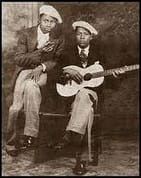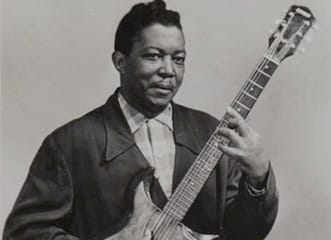Robert Nighthawk: A Journey Through the Blues
Introduction
In the heart of the Mississippi Delta, where the soulful notes of blues music echoed through the cotton fields, one man emerged as a true virtuoso of the genre. Let us embark on a captivating journey through the life and career of this legendary blues musician who left an indelible mark on the world of music.
Early Life and Musical Beginnings

Robert Lee McCollum, born on November 30, 1909, in the blues-infused town of Helena, Arkansas, was destined for greatness. At a young age, he set out on a musical odyssey, honing his craft as a busking musician, captivating passersby with his heartfelt melodies. His wanderings eventually led him to Memphis, Tennessee, where he immersed himself in the vibrant local music scene. Robert Lee McCoy’s initial recordings in 1937 were released under his own name on the Bluebird label, while later on, he adopted various monikers such as Rambling Bob, Peetie’s Boy (as a tribute to Peetie Wheatstraw), the Nighthawks, and eventually, by the early 1950s, he settled on Robert Nighthawk.
The Influences and Pseudonyms
During his time in Memphis, Nighthawk had the opportunity to collaborate with the legendary Houston Stackhouse, whose teachings enriched his music with the soulful sounds of slide guitar. It was during this period that he decided to adopt his mother’s name, becoming Robert Lee McCoy, a name that would resonate throughout his career.
From St. Louis to the Chicago Blues Scene
In the mid-1930s, Nighthawk made his way to St. Louis, Missouri, where he continued to evolve as a musician, collaborating with esteemed artists like Henry Townsend, Big Joe Williams, and Sonny Boy Williamson. In 1938, he participated in recording sessions that would mark the beginning of his musical legacy.
Resurfacing as Robert Nighthawk
In 1948, like a phoenix rising from the ashes, Robert Nighthawk emerged onto the blues scene, this time as an electric slide guitarist. He started recording for Aristocrat and Chess Records, becoming part of the same label as the legendary Muddy Waters. Nighthawk’s distinctive style captivated audiences and left a lasting impression on the blues world. In 1949, Nighthawk released the single “Annie Lee Blues”/”Black Angel Blues” on Aristocrat. During the 1940s and ‘50s, known for his radio broadcasts on KFFA in Helena, Arkansas, and WROX in Clarksdale,
The Nighthawk’s Legacy and Rediscovery
Nighthawk’s talent did not go unnoticed, and he gained recognition for his exceptional work. In 1949, “Annie Lee Blues,” released under the name ‘The Nighthawks,’ achieved considerable success on the Billboard R&B chart. Throughout the 1950s, he continued to record and perform, leaving a trail of heartfelt blues in his wake.
Robert’s slide-guitar skills, characterized by a combination of rhythmic energy and subtle one-string melodies, were acquired in the juke-joints of the Delta region. However, their impact resonated years later in the post World War II era in the clubs and bars of Chicago. While Elmore James is often acknowledged for bringing the slide-guitar to the city during the same period, it was Robert’s confident and assertive playing style that greatly influenced the likes of Muddy Waters and Earl Hooker, among others. Due to his deep roots in the Delta, he found it challenging to stray away from his musical origins.
The Rediscovery and Final Days

In 1963, fate smiled upon Nighthawk as he was rediscovered in the bustling streets of Chicago, strumming his guitar and captivating the crowd. This led to more recording sessions and club performances, but his health began to decline. In 1967, at the age of 57, Robert passed away, leaving behind a legacy that continues to inspire generations of musicians.
Nighthawk and His Flames of Rhythm performed at Maxwell Street in 1964. This live recording was originally released in 1964, and it has been reissued by Rounder Records in 1980 and 1991. Some versions of the reissue even include an extended interview with Nighthawk.
The Blues Hall of Fame Induction
Despite his untimely passing, Nighthawk’s contribution to the blues genre was undeniable. In 1983, the blues community paid homage to his talent and inducted him into the esteemed Blues Hall of Fame, forever immortalizing his name among the blues legends.
A Mark on the Mississippi Blues Trail
In 2007, the Mississippi Blues Commission honored Nighthawk by placing a historical marker in Friars Point, Mississippi, on the Mississippi Blues Trail. This marker commemorates the times when Nighthawk called the town his home during his nomadic musical journey.
The Enduring Musical Legacy
Nighthawk’s discography stands as a testament to his brilliance as a musician. His recordings, such as “Bricks in My Pillow,” “Prowling with the Nighthawk,” and “Ramblin’ Bob,” continue to captivate blues enthusiasts worldwide, preserving his artistry for generations to come. He was the father of the blues musician Sam Carr as well.
Albums
Here’s a comprehensive overview of his remarkable discography, spanning from classic blues recordings to posthumous releases:
| Album Title | Release Year |
|---|---|
| Presenting Robert Nighthawk | 1951 |
| Live on Maxwell Street – 1964 | 1979 |
| Complete Recorded Works in Chronological Order 1937 – 1940 | 1990 |
| Masters Of Modern Blues | 1994 |
| The Bluebird Recordings 1937-1938 | 1997 |
| Bricks in My Pillow | 1998 |
| Bye Bye Baby | 2002 |
| Prowling Nighthawk | 2004 |
| Saga Blues: Ramblin’ Bob | 2008 |
| ABC Of The Blues Vol 34 | 2010 |
| The Itinerant Bluesman | 2011 |
| G Man | 2007 |
| Kansas City | 2017 |
| Pre-War Blues | 2020 |
| Sliding the Blues – The Classic Years | 2021 |
| The Blues Collective – Robert Nighthawk | 2023 |
His discography stands as a testament to his brilliance as a musician, with each album offering a unique glimpse into the soulful world of blues. From his early recordings in the 1930s to rediscoveries and posthumous releases, his musical journey continues to captivate blues enthusiasts worldwide.
Conclusion
Robert Nighthawk shines brilliantly in the blues universe. He left a legacy of soul-stirring music. Nighthawk’s journey from Helena, Arkansas, to the Blues Hall of Fame embodies the blues spirit. This genre touches millions and thrives in musicians and music lovers alike. Let us remember this blues legend, who traversed the blues landscape with his extraordinary talent and left an enduring mark on the history of music.
Q: Who is Robert Nighthawk?
A: Robert Lee McCollum, born on November 5, was an influential American blues musician with a unique playing style.
Q: What are some of his notable recordings?
A: Nighthawk’s notable recordings include “Black Angel Blues,” “Annie Lee Blues,” “Prowling Night-Hawk,” and “I Need Love So Bad.”
Q: What role did Robert play in Muddy Waters‘ first wedding?
A: He played at Muddy Waters’ first wedding, adding musical flair to the celebration.
Q: What were some of Nighthawk’s early influences?
A: Robert was influenced by the Memphis Jug Band, Tampa Red, and other notable blues musicians of his time.
Q: How did Robert get the name “Robert Nighthawk”?
A: People gave him the nickname “Nighthawk” due to his love for playing blues late into the night.
Q: What is King Biscuit Time?
A: King Biscuit Time was a radio program that aired on KFFA in Helena, Arkansas. The region’s blues music development was majorly influenced by it, showcasing many talents, including Nighthawk.
Q: Where was Robert born?
A: He was born in Helena, Arkansas.
Q: When did Nighthawk settle?
A: Nighthawk settled for a time in St. Louis, Missouri, where he became an integral part of the local blues scene.
Q: Was he inducted into any Hall of Fame?
A: Yes, he was inducted into the Blues Hall of Fame in 1983, recognizing his contributions to the genre.
Q: At what age did Robert leave home?
A: Nighthawk left home at an early age to pursue his passion for music and embark on his blues journey.


